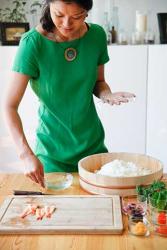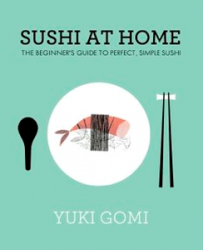 The first thing I’m struck by is just how friendly Yuki Gomi is when she flings open the door to her home training kitchen. I’d expected a sushi teacher to be cold, neat and slightly clinical – a bit like sushi.
The first thing I’m struck by is just how friendly Yuki Gomi is when she flings open the door to her home training kitchen. I’d expected a sushi teacher to be cold, neat and slightly clinical – a bit like sushi.
My second impression is how she carries off elegance while being so very perky. These made up for the trek to a residential backwater in the depths of Crystal Palace. And once in her pristine kitchen, our sushi-making class was much more engaging that I’d expected for a food so sensible.
The bubbly Yuki talks a lot, frilling us with her anecdotes as the four of us in this intimate group sip wine or barley tea. First she washes the sticky rice, which has been soaked overnight, then seasons it with vinegar. The vinegar is not just for taste but stops nasty bacteria colonising the rice. The rice emits a sudden tang – exciting but only fleeting. I can’t tell from notes if Yuki says that or I think it but it’s true. Yuki tells us that her mentor spent four years from age 14 simply washing rice while he trained. Which is as dedicated as they come.
Finally Yuki’s cooking the stuff. “Rice cookers are more important than TV!†she exclaims. There is lots of explaining which is good. It’s pretty self-evident what the table fan is doing as she blasts it on the cooked rice so that it cools quickly without becoming mushy. You can also use a hairdryer she says, to stop the rice becoming too gluten and starchy.
This making sushi rice is more pernickety than I’d imagined but Yuki reminds us that in Japan, sushi is a celebration rather than everyday food. She also informs us not to keep it in the fridge, which spoils its taste – no wonder the high street fast food is so anaemic.
We’re making hosomaki, the small sushi rolls wrapped in nori seaweed most familiar to us in the West. This involves patting and spreading the prepared rice – now moist and shining – down onto a strip of nori seaweed before layering on a simple strip of avocado or cucumber. We roll the little morsels in a bamboo mat till the nori joins up then plop them into a dish.
 We also make futo-maki or fat rolls with a tasty sweet dashi-maki tamago (omelette) that Yuki helps us to make in a special square pan. We try other variations: hand rolls with creamy avocado sauce, and use delicious fresh tuna for some of the fillings.
We also make futo-maki or fat rolls with a tasty sweet dashi-maki tamago (omelette) that Yuki helps us to make in a special square pan. We try other variations: hand rolls with creamy avocado sauce, and use delicious fresh tuna for some of the fillings.
The tuna is sliced by a frighteningly sharp Kai knife, like a Samurai sword. The creaminess is created by that very Japanese of condiments: mayonnaise. “Japanese people love mayonnaise, did you know that?†she asks? “It’s become the Japanese national sauce.â€Â
We’re now merrily sprinkling flying fish roe and sesame seeds onto everything. When we make the “inside out†roll with the rice and sesame seeds on the exterior, I’m shocked to hear that this is an American invention created because our shoulder-to-shoulder pals wanted their food white, not black like true sushi. This explains a lot but Foodepedia is not the place for politics.
I left feeling that every piece of sushi I took home was both simple and special. Yuki is excellent at giving detail to and making fun of something I’d assumed was easy to make. Now to dig out my hairdryer.
Japanese Char Siu – Slow Cooked Pork with Green Tea -recipe
Baked Salmon with Ginger and Shitake Mushroom sauce – recipe
@Yukiskitchen
A yen for more Japanese? Then read
